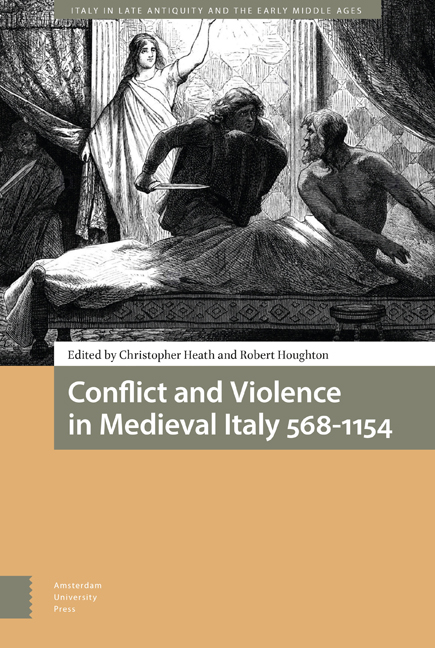Book contents
- Frontmatter
- Table of Contents
- Abbreviations
- Preface
- 1 Introduction: Discordant Minds and Hostile Nations
- 2 Morbidity and Murder: Lombard Kingship’s Violent Uncertainties 568-774
- 3 Insurgency and Counterinsurgency in Lombard Italy (c600-700)
- 4 Troubled Times: Narrating Conquest and Defiance between Charlemagne and Bernard (774-818)
- 5 ‘Nec patiaris populum Domini ab illis divinitus fulminandis Agarenis discerpi’: Handling ‘Saracen’ Violence in Ninth-Century Southern Italy
- 6 Formosus and the ‘Synod of the Corpse’: Tenth Century Rome in History and Memory
- 7 Sex, Denigration and Violence: A Representation of Political Competition between Two Aristocratic Families in Ninth Century Italy
- 8 ‘Italy and her [German] Invaders’: Otto III’s and Frederick Barbarossa’s Early Tours of Italy – Pomp, Generosity and Ferocity
- 9 ‘I Predict a Riot’: What Were the Parmense Rebelling Against in 1037?
- 10 The Strange Case of Deusdedit and Pandulf: Two Accounts of Honorius II’s Election
- Afterword
- Index
3 - Insurgency and Counterinsurgency in Lombard Italy (c600-700)
Published online by Cambridge University Press: 07 September 2022
- Frontmatter
- Table of Contents
- Abbreviations
- Preface
- 1 Introduction: Discordant Minds and Hostile Nations
- 2 Morbidity and Murder: Lombard Kingship’s Violent Uncertainties 568-774
- 3 Insurgency and Counterinsurgency in Lombard Italy (c600-700)
- 4 Troubled Times: Narrating Conquest and Defiance between Charlemagne and Bernard (774-818)
- 5 ‘Nec patiaris populum Domini ab illis divinitus fulminandis Agarenis discerpi’: Handling ‘Saracen’ Violence in Ninth-Century Southern Italy
- 6 Formosus and the ‘Synod of the Corpse’: Tenth Century Rome in History and Memory
- 7 Sex, Denigration and Violence: A Representation of Political Competition between Two Aristocratic Families in Ninth Century Italy
- 8 ‘Italy and her [German] Invaders’: Otto III’s and Frederick Barbarossa’s Early Tours of Italy – Pomp, Generosity and Ferocity
- 9 ‘I Predict a Riot’: What Were the Parmense Rebelling Against in 1037?
- 10 The Strange Case of Deusdedit and Pandulf: Two Accounts of Honorius II’s Election
- Afterword
- Index
Summary
Abstract
The purpose of this chapter is to examine cases of insurgency and counterinsurgency in roughly the first half of the Lombard's dominion in Italy. The lack of a sustainable system of royal succession was a crucial factor for the trend to take power by a coup d’état. Italy was not only divided by its physical geography, but also by various powerful actors with different aims. The enduring rebellions of the sixth- and seventh centuries have traditionally been taken as an indication of a general weakness of Lombard royal power. Incidences of insurgency and the measures against them can be repeatedly observed and studied to comprehend the frequency and subsequently find new ways to understand the history of this militarised society.
Keywords: Lombards, Lombard Italy, violence, rebellion, insurgency and counter-insurgency, Lombard kings and duces.
One of the common features frequently claimed in modern historiography is that the Lombard state was a comparatively weak one, and that the reasons for this weakness are to be found in the selfish interests of the powerful Lombard duces. These dukes were aristocrats and office holders, in charge of armies and responsible for the defence of the kingdom. Nonetheless, they frequently tried to enlarge their own power and territories at the expense of either other magnates or the king. To achieve their goals they did not even hesitate to defect to the Lombard's enemies. Both externally and internally, the interests of the Lombard kingdom could only be secured through the maintenance of strong armies. Leadership of these troops fell in the sphere of responsibility of either the king or the duces or gastaldi. Ruling Lombard Italy therefore, demanded that one deal with the interwoven interests of all involved and powerful magnates on the one hand, and to secure the territory against foreign enemies on the other. Furthermore, the presence of Byzantine administration and military promoted insurgencies by paying and supporting ambitious Lombard lords who were willing to change sides for their own benefit. The entanglement of different players on Italian territory was even broader as there were also Frankish and Papal intentions to gain as much power in Italy as possible.
- Type
- Chapter
- Information
- Conflict and Violence in Medieval Italy 568-1154 , pp. 87 - 116Publisher: Amsterdam University PressPrint publication year: 2021

